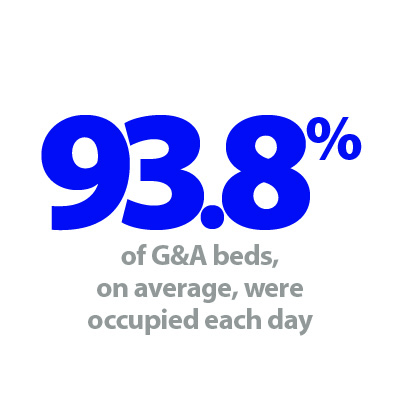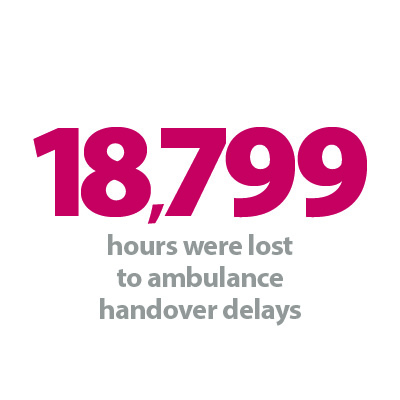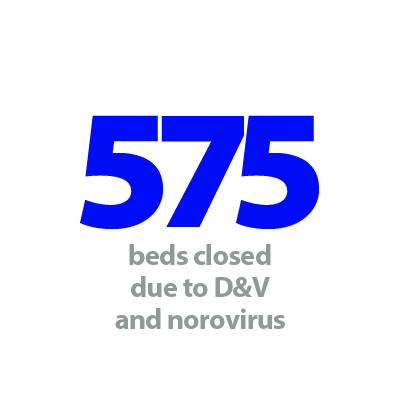


Introduction
Today NHS England published another release of its weekly winter situation reports, providing useful insight into performance in trusts across the country.
This week's winter data (19 – 25 February) continue to demonstrate the challenging situation on the ground. Winter pressures persist, and we are still seeing too many patients remaining in hospital despite being medically fit to leave, contributing to overall high bed occupancy levels. Encouragingly, this week saw some improvements in the data, including fewer hours lost to ambulance handover delays, and fewer patients in hospital with seasonal viruses – but these remain high, and conditions for staff in trusts continue to be tough.
Winter situation report (19 – 25 February)
A&E closures and diverts: There were no A&E closures this week. There were 28 A&E diverts, three more than the week prior but one less than the same week last year.
Ambulance arrivals: A total of 91,597 patients arrived by ambulance. An increase of 2.5% since last week and up by 17% compared to the same week last year.
Ambulance handovers: 27% of ambulance handovers were delayed by 30 minutes or more, down from 29.9% last week but up from 25.8% at the same point last year. 9.5% were delayed by 60 minutes or more. This is down from 12.0% last week and down from 11% last year. A total of 18,799 hours were lost to ambulance handover delays, a decrease of 20% from last week but 3.5% higher than the same time last year.
Critical care: Adult critical care bed occupancy is at 79.7% this week; this is lower than the week before (80.2%) but higher than this time last year (78.4%).
Diarrhoea and vomiting (D&V): The number of beds closed due to D&V and norovirus has decreased this week, with an average of 575 closed per day. This is down from 607 last week and is lower than this week last year (710).
Discharges: There were an average of 24,141 patients each day who no longer met the criteria to reside, a smaller number compared to last week (295 fewer). Of these, over half (54.8%, 13,222) remained in hospital, a smaller proportion than the week prior (55.8%) and lower than the level seen last year (58.4%).
Flu: This week the average number of general and acute beds occupied by flu patients each day decreased by 17% but remained high at 1,740. This is 3.6 times greater than the same time last year (487). An average of 97 critical care beds were occupied by flu patients each day this week (13% fewer than the week before), 3.1 times greater than last year (31).
General and acute (G&A) beds: There were an average of 103,273 G&A beds open each day across all acute trusts. On average each day, 62 G&A beds were unavailable and void to non-Covid admissions. Average bed occupancy remains at a similar rate to last week at 93.8%, slightly lower than the same time last year (94.1%).
Long stay: The number of patients staying in hospital longer than seven and 14 days has decreased since last week (down by 1.2% and 0.8% respectively). The number of patients staying longer than 21 days has remained at the same level.
Neonatal intensive care beds: For all trusts, bed occupancy has increased from last week and is at 68%, down from 69.7% last week. The average number of care beds open is at 1,724, the same level as last week (1,720).
Paediatric intensive care beds: For all trusts, bed occupancy has decreased this week to 75.4%, down from 77.5% last week. The average number of care beds open has fallen this week by six beds to 366. The average number of care beds available has risen by six beds to 90.
Respiratory syncytial virus (RSV): An average of 10 beds were closed this week due to RSV symptoms, down from 11 last week but up from 8 last year.
Staff absences: There were an average of 46,191 total absences each day this week, of which 2% were Covid-19 related (1,111). The total number of staff absences has decreased from the week before (46,834), and the proportion of Covid-19 related absences has decreased from 3%.
Our view
This week's winter figures highlight the sustained, intense pressure being felt across urgent and emergency care. The number of patients arriving by ambulance was among the highest so far this winter at almost 92,000, illustrating the challenging conditions that staff are working in. Despite this increased demand, there have been improvements in ambulance handover delays, demonstrating the commitment of staff to reduce these.
Inside hospitals, occupancy levels remain high despite the NHS opening more beds than last winter. G&A bed occupancy rates are still as concerningly high as last year at 94%, despite more capacity, with over 2,000 additional beds open. Although adult critical care bed occupancy has fallen this week and is the lowest it has been for the past six weeks, it remains higher than this time last year.
There have been some signs of improvement in this week's data. We have seen decreases in the number of patients in hospital with D&V, norovirus, and flu, suggesting a slight easing of pressures arising from seasonal illnesses. However, the number of beds closed due to flu is still considerably greater than this time last year, and numbers closed due to D&V and norovirus remain high.
As well as the winter situation reports data published by NHS England today, the NHS published the latest vacancy statistics for December 2023. While there has been a decrease from the previous quarter, the NHS still has almost 111,000 vacancies. Furthermore, this week saw another junior doctors' walkout, this time lasting five days. Workforce shortages continue to exacerbate the winter pressures that trusts face, and we urge government and unions to resolve disputes and put an end to this industrial action.